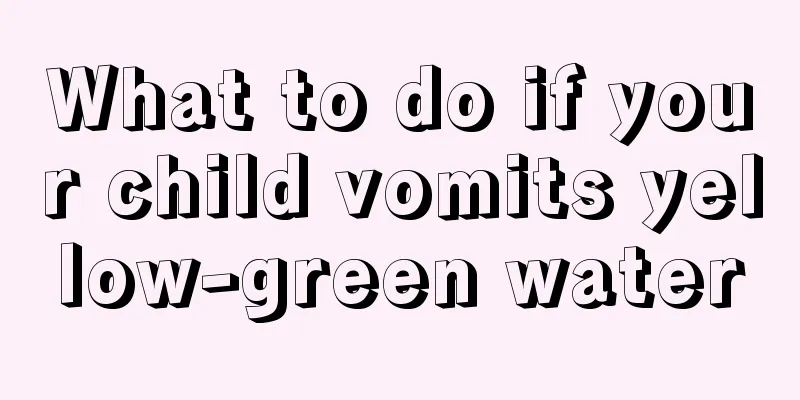Reasons for yellow urine in six-month-old babies

|
Many parents are particularly worried when their six-month-old babies have yellow urine, because if babies in this period have yellow urine, it means that their children have a disease in their bodies. Therefore, many parents want to fully understand the cause of yellow urine. The following content makes a detailed introduction, so many parents can have a comprehensive understanding. There are two reasons why baby's urine is yellow: one is physiological; the other is pathological. The pathological condition is that the urine is always yellow and needs treatment. If it is indirect, it means that the child has a high fever and needs some time to cool down. 1. Physiological yellow urine. Yellow urine is one of the typical symptoms of a baby getting angry. Children have a faster metabolism, but their digestive system is immature. The secretion of gastric acid and digestive enzymes is less, and the activity of digestive enzymes is low. They cannot withstand large changes in dietary substances and quantities, which can easily cause "internal heat", commonly known as getting angry in traditional Chinese medicine. Improper diet or improper feeding methods can cause yellow urine. 2. Pathological yellow urine. Urinary tract infection can cause yellow urine, but urinary tract symptoms are not obvious in newborns and infants under one year old. Most children only experience fever, reluctance to eat, pale complexion, vomiting, diarrhea, abdominal distension and other systemic symptoms that are not caused by urinary tract infection. If you find that your baby cries when urinating, or has frequent urination or persistent diaper rash, there may be an infection of the urinary organs. You should see a doctor as soon as possible and have a regular urine test. Methods for treating and preventing physiological yellow urine: 1. Drink more water: Babies need a lot of water every day, and the amount of water each time they are fed is about half of the amount of milk per meal: 30 ml in the first week after birth; 45 ml in the second week; 50-60 ml after 1 month; 60-75 ml at 3 months; 70-80 ml at 4 months; 80-100 ml at 6 months; 100-120 ml at 8-12 months. The amount of water should be increased appropriately in summer. 2. Regulate internal heat Choose breastfeeding whenever possible. For babies who drink high-calorie foods such as formula milk and fresh milk for a long time, you can choose plant-based heat-clearing products that are both medicinal and edible to relieve the symptoms of yellow urine caused by internal heat, achieving the heat-reducing effect of "one clear, two moisturizing, and three comfortable". Products such as Meiban's "Qingqingbao" are safe and have no side effects. Mixing it with milk or directly using warm water can achieve the effect of balancing the calorie intake from food, gently reducing heat without being too cold. Be careful to choose fire-clearing products that are trustworthy and have a good reputation. The above content has given a comprehensive introduction to the reasons why six-month-old babies have yellow urine. I believe that many parents also have a comprehensive understanding of the reasons why six-month-old babies have yellow urine. Therefore, after a comprehensive understanding, it is best to take the child to a large hospital and through comprehensive treatment, let the child’s urination return to normal as soon as possible, which will be beneficial to the normal growth of your child. |
<<: The harm of sudden lack of urine in babies
>>: Treatment of cough and runny nose in eight-month-old baby
Recommend
Why is my baby vomiting and having diarrhea?
After birth, the baby's body is in a state of...
What should I do if my child has a fish bone stuck in his throat?
Fish meat is a kind of meat that we like to eat v...
Why does my baby keep blowing bubbles from his mouth?
Every baby is the treasure of the family. We hold...
What are the consequences of severe baby eczema?
Every child is the center of the family, especial...
Symptoms of rhinitis in a three-year-old child
Rhinitis is most of the time a disease caused by ...
Do babies all get rashes?
Rashes are a common phenomenon in life, especiall...
How to effectively treat trachoma in children
The impact of trachoma on children must not be ig...
How to distinguish the authenticity of one-year-old baby milk powder
Milk powder is food for children. It is also what...
What to do if your baby develops a rash after a fever
In daily life, we often encounter children having...
What are the benefits of breastfeeding for newborns?
Breastfeeding is a feeding method advocated by ou...
Should children take anti-inflammatory drugs for cough?
Whenever the weather reaches autumn and winter, c...
Causes of allergic dermatitis in children
When it comes to diseases like dermatitis, many p...
What can’t children eat when they have a fever? 6 types of food to avoid
In cold seasons, babies are very likely to catch ...
What to do if your child grinds his teeth while sleeping
It is a common phenomenon for children to grind t...
What should I do if my child has strabismus?
Some babies are born with strabismus, while other...









